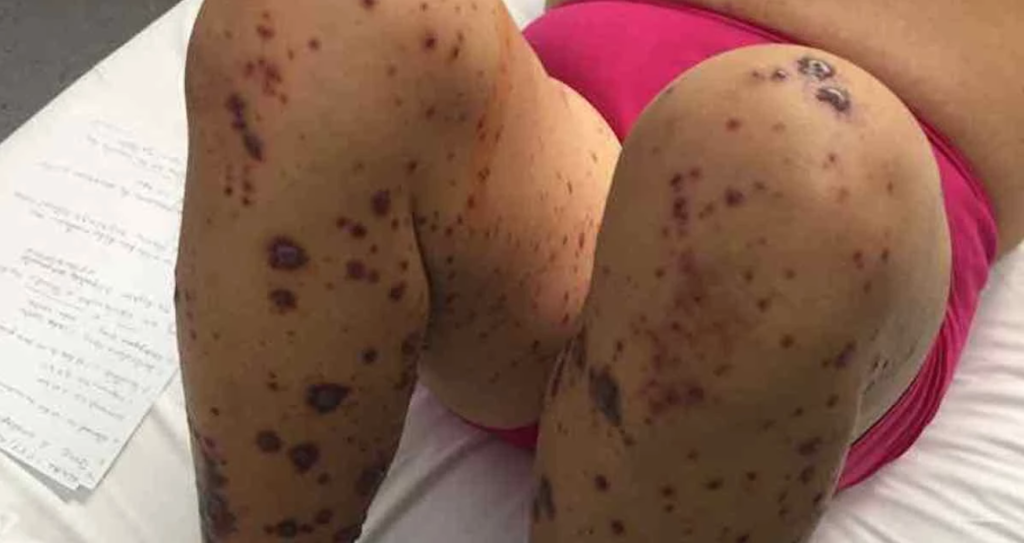
Learning Objective
- To understand a differential diagnosis of painful rash
A 52-year-old presents with a three-day history of progressive, painful rash. The rash started on the feet and legs and has been moving up the body and is now on the trunk, arms, and hands. The patient notes that the rash is painful to the touch and is mildly pruritic. They also deny any constitutional symptoms such as fever, nausea, diarrhea, abdominal pain, headache, or other symptoms. The patient does report taking amoxicillin about a week ago for a dental abscess that has since resolved.
On examination, the cutaneous lesions are varied in size, palpable, non-blanching, smooth in texture and with sharply delimited borders. Vital signs are normal: temperature 98.6 degrees Fahrenheit, blood pressure 110/70, heart rate 80, respiratory rate of 12 and BMI of 22. Physical exam reveals the rash as noted above, but normal cardiac and lung exam, no hepatosplenomegaly, no obvious retinal lesions, no Janeway lesions or splinter hemorrhages or any other abnormal physical finding. Lab results are normal including a CBC with differential, complete metabolic panel, erythrocyte sedimentation rate, liver enzymes, autoantibodies including ANCA, rheumatoid factor, VDRL, hepatitis serologies, HIV, bleeding times, and complements.
Initially a limited differential diagnosis includes: leukocytoclastic (hypersensitivity) vasculitis, thrombotic thrombocytopenia purpura (TTP), pigmented purpura (capillaritis), polyarteritis nodosa (PAN) and Wegener granulomatosis with polyangiitis.
A biopsy of on one of the skin lesions reveals neutrophils around an arteriole without IgA deposition. The presence of the pathological finding combined with an age greater than 16 years, taking a medication at the onset of the rash that may have induced the reaction and palpable purpura are 4 of the 5 criteria used to confirm the diagnosis of hypersensitivity vasculitis.
The patient had a normal platelet count, which excludes TTP. The biopsy did not show perivascular lymphohistiocytic inflammation, excluding pigmented purpura. Polyarteritis nodosa is less likely given the lack of systemic symptoms and normal serologies, although the biopsy findings can overlap. Wegener granulomatosis with polyangiitis is also less likely given the lack of other symptoms combined with a negative ANCA finding.
The patient’s amoxicillin was discontinued, they were given compression stockings and instructed to elevate the legs. They were also given an antihistamine for pruritis and instructed to use ibuprofen as needed for discomfort. After two weeks the lesions resolved.
Further Reading
References
Calabrese LH, Michel BA, Bloch DA, Arend WP, Edworthy SM, Fauci AS, Fries JF, Hunder GG, Leavitt RY, Lie JT, et al. The American College of Rheumatology 1990 criteria for the classification of hypersensitivity vasculitis. Arthritis Rheum. 1990 Aug;33(8):1108-13. doi: 10.1002/art.1780330808. PMID: 2202309.
MacLeod B, Koponen M. Educational case: hypersensitivity vasculitis. Academic Pathology. 2021 Jan;8:23742895211030650.
Mushlin SB, Greene HL. Decision making in medicine: an algorithmic approach. Elsevier Health Sciences; 2009. 753 p. Available from: https://bit.ly/3UiEbe3
Originally published June 8, 2021; updated November 30, 2022
Want more clinical cases?
Join Figure 1 for free and start securely collaborating with other verified healthcare professionals on more than 100,000 real-world medical cases just like this one.